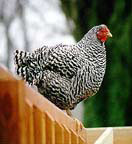

The American Livestock Breeds Conservancy's initial poultry research was published in 1987 as the Poultry Census and Sourcebook. A new study is underway. The listings have been updated for turkeys in 1999 and ducks and geese in 2000 to reflect our understanding of the status of the breeds and varieties. We expect to complete the chicken research in 2002. Our focus is on genetically distinct stocks that have been of economic and historic significance in North America. Rapid genetic erosion is occurring in the poultry species globally, so we are also evaluating breeds of recent development of importation.
Conservation categories are based on the estimated number of breeding birds, males and females, and the number of breeding flocks. Given the vulnerability of poultry to predators, the number of flocks is important. "Conservation breeding flocks" are those of 50 birds and above.
Categories
| Critical:
Fewer than 500 breeding birds in North America, with five or
fewer primary breeding flocks.
Rare: Fewer than 1,000 breeding birds in North America, with seven or fewer primary breeding flocks. Watch: Fewer than 5,000 breeding birds in North America, with ten or fewer primary breeding flocks. Also included are breeds which present genetic or numerical concerns or have a limited geographic distribution. Study: Breeds which are of interest but either lack definition or lack genetic or historical documentation. Recovering: Breeds which were once listed in one of the other categories and have exceeded Watch category numbers but are still in need of monitoring. |
|
Chickens
|
||||
| Critical | Rare | Watch | Study | Recovering |
|
Ancona
Java |
Non-industrial Leghorn | Australorp | All other breeds listed as critical by the Society for the Preservation of Poultry Antiquities (SPPA) | |
|
Ducks
|
||||
| Critical | Rare | Watch | Study | Recovering |
| Ancona | Buff (a.k.a. Orpington) |
Campbell
Runner (a.k.a. Indian Runner) |
Australian Spotted* | |
|
Geese
|
||||
| Critical | Rare | Watch | Study | Recovering |
| American Buff* | Sebastopol |
African***
Toulouse**** |
Shetland
Gray |
|
|
Turkeys
|
||||
| Critical | Rare | Watch | Study | Recovering |
|
Beltsville Small White*
White Midget* |
Bourbon Red* | Broad Breasted Bronze* | Other color varieties of standard turkeys. | |
| * Originated in the
United States.
** Rouen: Two distinct types, the production birds and the larger exhibition birds. *** African: The large, dewlapped bird reflects the original phenotype, is an exceptional meat bird and is of conservation interest. The smaller African goose likely contains some influence of the Chinese goose, a relative of the African. **** Toulouse: There are three distinct types. All are of conservation interest. The standard Toulouse, a large, dewlapped bird with elongated feathers, loose skin, and a keel, is a good layer and is a unique color of gray. The smaller Toulouse is a longer legged, tightly feathered, keel-less goose with no dewlap. The exhibition Toulouse has an exaggerated dewlap. |
Changes to the ALBC Conservation Priority List 2000
Parameters for Livestock Breeds on ALBC Conservation Priority List
Revised May 14, 2002
| The American Livestock Breeds Conservancy | |
| P.O. Box 477 | ALBC is a
trademark of American Livestock Breeds Conservancy. Copyright © 1993 American Livestock Breeds Conservancy. All rights reserved. |
| Pittsboro, North Carolina 27312 USA | |
| Telephone: (919) 542-5704 | |
| Fax: (919) 545-0022 | |
|
|
|
| Site design and maintenance Princess Puddin Face Webdog Productions. | |
|
HOME
About ALBC
ALBC store
Conservation Priority List Upcoming Events Waterfowl Census Other sites of Interest Special Alerts Become a Member of ALBC Support ALBC Contact ALBC |
|